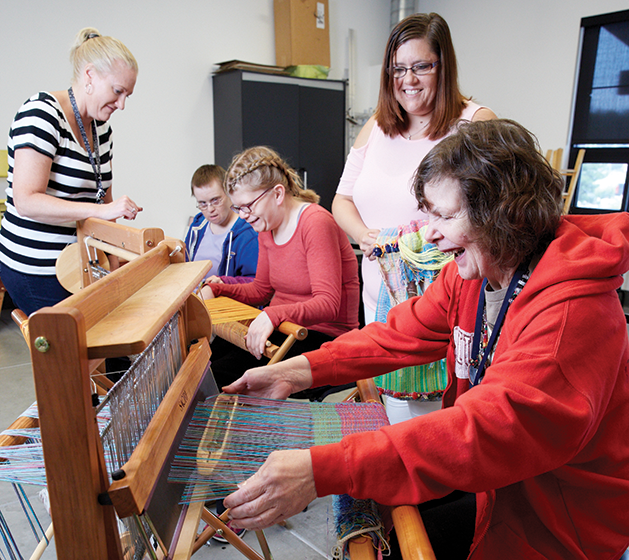
Bloom—it’s a name that conjures up beauty and growth, and it fits perfectly for the ladies that make up this group of eight. Bloom uses a method of weaving called Saori to create one-of-a-kind-scarves. What makes Bloom unique is that it’s comprised of women with disabilities who not only make beautiful products, but teach Saori weaving to others. Bloom does their weaving at White Bear Center for the Arts, where the scarves are sold, and where Bloom teaches classes in Saori weaving.
The members of Bloom are supported in their employment by TSE, a company that works with people with disabilities to provide job training, career exploration and other services.
Bloom began as a job training program, says Kristen Lightner, services coordinator for TSE’s Roselawn office. Chiaki O’Brien a weaver and teacher of weaving taught the ladies how to do Saori, and it turned out to be the perfect match. “Saori is an especially good style of weaving for people with disabilities, the ladies took off with Saori, and now are teaching it to others," says says Lightner.
About two years ago, Bloom partnered with the WBCA. Lightner says the partnership has been pivotal in transforming Bloom from a group of weavers into a group of artists.
“Partnering with the center was probably the turning point. WBCA saw the members of Bloom as artists, and accepted them as artists and teachers. [For Bloom members] teaching to people who don’t have disabilities is very empowering” says Lightner.
"Bloom represents the creativity in all of us. They are here as artists and teachers to create and inspire us," says Danielle Cezanne, WBCA program director.
TSE provides on the job coaching and support to the ladies as they weave and teach.
TSE sells the scarves at a price that allows everyone who works on a piece to get minimum wage for their work, and to cover the costs of materials. “The autonomy this creates is an important part of what happens,” says Lightner. Saori is a newer type of weaving that began about 50 years ago and was created in Japan, O’Brien says, “Saori comes from the words ‘sai’ meaning ‘everything has its own dignity,’ and ‘ori,’ which means weaving, Saori isn’t just a method of weaving, says O’Brien. “It’s a philosophy. The most important part of the philosophy is that there are no mistakes in Saori.”
“Flaws” that would be considered mistakes in other types of weaving are viewed as an integral part of the piece, O’Brien explains. She says that unlike other styles of weaving, Saori is easier for beginners than for people who have experience with weaving. “People who do other kinds of weaving don’t want to break the rules,” says O’Brien. "Saori weaving has only one rule: don’t break the loom. But in twenty years,” she says, “no one has ever broken one.”
“Don’t worry about what colors you use or anything. Whatever you choose is you, it’s from your heart,” says O’Brien. “Use your heart for this,” says O’Brien, give your head a rest, and it will be beautiful.









